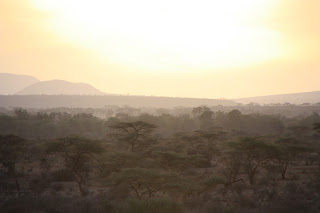 |
| Grevy's Zebra ((Left) & Common Zebra (Right) |
Tiny deer "dik-dik", no bigger than a cat, tiptoed on their needle-like legs nervously herding together while stealing quick little nibbles at small acacia shoots.
Larger antelope with svelte long legs performed ballet in groups, pirouetting left in sweeping arcs to bigger acacia bushes then swaying to the right, following the lead male with magnificient horns.
Long-necked gerenuk stretched elegantly, elongating their limbs to snip at the highest juicy leaves from the bushes.
Giraffe stood tall with their towering necks entwined as they stooped down to graze on the lofty tops of the acacia trees.
Witnessing so many animals feeding at different heights at the acacia trees we wondered how the poor acacias managed to survive under such relentless attack. We learnt that this hardy tree has natural defences that includes large thorns, chemically unpleasant alkaloids and under some conditions the leaves can produce posionous cyanides that can poison animals if too much of it is eaten. Acacia trees are used across the world for gum (e.g. chewing gum), food, medicine, paint, tannin, perfume, land reclamation, wood and fuel... truely the ancient Egyptians' "Tree of Life".
As we pondered the usefullness of the acacia trees, a delicate but curious little jackal loped up to our safari van and with its intent stare, silently investigated us as we paused along the dusty track to admire its beautiful, large and alert ears. Then as silently as this beauty had appeared, it quietly slipped away into the bush saving its voice for dusk for more worthy purposes such as contacting its mate, family and friends.
It was only afternoon and we headed back to the safari lodge for lunch with great anticipation of what the late afternoon and dusk would have in store for us and then there was a flurry of excitement as some one had spotted some big game on the side of the river so off we headed down to the riverside.
What we spotted made our morning safari all the more worthwhile...






